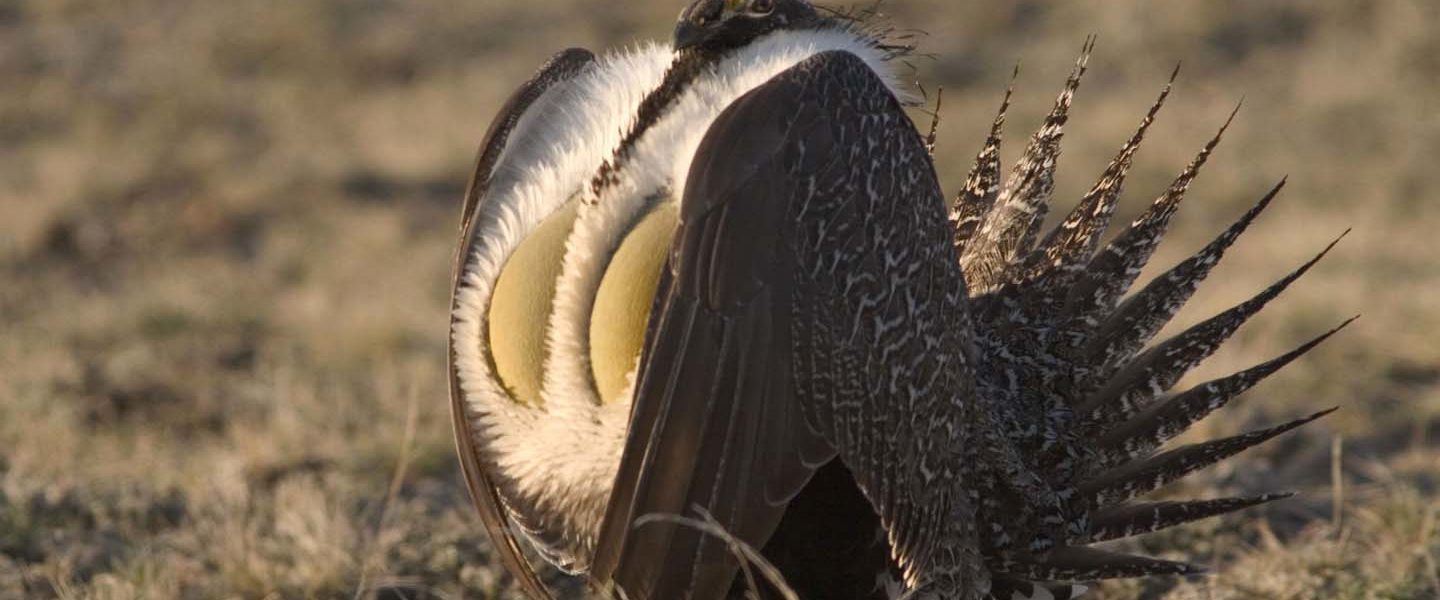By Angus M. Thuermer Jr., WyoFile.com
Greater sage grouse populations in Idaho, Nevada and Oregon have fallen for a third consecutive year, spring counts indicate, supporting fears the troubled bird may be on a west-wide population slide.
The three states hold about 42% of the species’ population and surveys show each saw bird numbers decline between 2018-2019. Idaho statewide lek counts indicate a 25% decline in males. Nevada saw 8% fewer males on breeding-ground leks, officials there report. Oregon’s population estimate is down 24.9% from last year, Sage Grouse Conservation Coordinator Lee Foster told WyoFile on Monday.
“The population [last] peaked in 2016,” Foster said. “This is the third year of decline,” in Oregon including a 7.7% drop between 2016-2017 and a 10.2% drop between 2017-2018.
In Idaho sage grouse numbers “are down 52% from the peak counts in 2016,” the state Department of Fish and Game wrote on its website. Nevada lek counts in 2019 were down 33% from 2016, (28.2 males/lek in 2016 vs 18.8 males/lek in 2019) according to WyoFile calculations made from state data.
The counts buttress anecdotal and local reporting of a poor 2019 spring census in Wyoming and possibly west-wide. Biologists are reluctant to draw conclusions from a single year’s count, and even a three-year trend doesn’t spell doom because greater sage grouse populations are cyclical.
“A year-to-year trend is obviously not super useful with a species that goes through population cycles,” Foster said. “A 3-year decline is fairly common. It seems like we’re typically looking at a 6-year to 10-year cycle between peaks and troughs.”
Nevertheless, “we’re very low,” Foster said, calling his state’s estimates “not a rosy picture.” He said he tells Oregon residents that while the local scene “is pretty nasty,” the decline is happening not only in the Beaver State but that “it’s fairly consistent across the range.”
Foster cautioned that a late winter and wet spring may have interfered with Oregon’s detailed method of counting birds and estimating populations, and skewed estimates downward.
Nevertheless, “we’ve seen a long-term decline in Oregon since 1980,” Foster said. The counts are “acting like a population cycle,” he said, but “we’re also losing habitat to the extent the ceiling and floor of our population cycle is likely dropping.”
2019 marks “the lowest result out of that [population] model that’s been generated since we started [using it] back in 2011,” he said. “We better be at the floor. If we don’t turn around next year, personally I’ll start getting pretty concerned.”
Wyoming expects to confirm spring counts in coming weeks, grouse coordinator Leslie Schreiber wrote WyoFile in an email. But experts have said they expected 2019 to be another down year.
In May Wyoming Game and Fish Department’s former sage grouse leader warned that low lek counts here and across other states could indicate numbers are down to a 24-year low. Wyoming holds more greater sage grouse than any other state, almost 39% of the world’s population.
As apparently dire grouse censuses roll in, oil and gas activity advances with new vigor into Wyoming’s key grouse habitat under President Trump’s so-called energy dominance policy, according to a report released last week by three conservation groups. The administration on Friday further threatened protections of greater sage grouse, critics say, under proposed revisions to U.S. Forest Service policies.
Energy companies have obtained drilling approvals under Trump rules at a rate that is more than six times higher than under previous policies, according to a report released last week by The Wilderness Society, the National Audubon Society and the National Wildlife Federation.
Western Ecosystems Technology, Inc. wrote the report “Oil and Gas Development on Federal Lands and Sage-Grouse Habitat,” which compared leasing proposals, sales and drilling approvals under policies between October 2015 and March 2019. The spike in drilling approvals amounts to a more than six-fold (6.63 times) increase, authors of the study confirmed to WyoFile.
The 37-page report made the comparisons between 16 months under Obama rules and the 25.5 month period when federal regulators operated under Trump’s less-restrictive policy. Because the two periods spanned different lengths of time, authors made comparisons on a per-month average basis.
Under Trump policies, federal regulators approved drilling permits in Wyoming’s primary or core grouse habitat a rate of 5.8 a month compared to fewer than one a month under pre-energy-dominance rules. All told, oil and gas companies won approval to drill 148 wells in Wyoming’s Primary Habitat Conservation Areas, roughly equivalent to the state’s core areas, under the Trump doctrine, according to the report.
There were 14 approvals under the rules adopted by the Obama administration and designed to keep the bird off the list of threatened or endangered species, the report said.
The report highlights an “irresponsible shift in priorities,” Audubon Vice President of Public Lands Nada Culver said in a press call. Trump’s policies resulted in increased leasing and drilling authorizations in core greater sage grouse habitat in contrast to previous efforts to focus development outside those mapped zones.
Energy industry officials have said leasing cannot be equated to actual disturbance of grouse habitat for a variety of reasons, including that oil and gas reserves can be accessed by directional or horizontal drilling away from critical habitat. But approval of drilling permits supports the criticism that Trump policies are having an actual impact.
In addition to increases in Wyoming, the number of drilling permits approved per month in priority or core sage grouse habitat across the West was seven times higher under Trump compared to activity under Obama, the groups said. The rate of acres leased in priority habitat increased 10 fold, the report said.
The federal government under Trump leased lands in primary sage grouse habitat at a rate of 20,566 acres a month, according to WyoFile calculations made from the report. Under Obama, the rate was 2,382 acres a month.
The percent of total acreage leased that fell in primary habitat increased from 13.7% under Obama to 45.1% under Trump, the report says.
The switch undermines “one of the key commitments,” designed to keep greater sage grouse from becoming threatened or endangered, Culver said. That commitment was prioritizing leasing and development outside the priority or core habitat.
“We know these impacts will be devastating,” she said. “This onslaught … will continue.”
An executive order by Wyoming’s governor aims to protect greater sage grouse in the Equality State, stating “all efforts to encourage, enhance, and prioritize development outside of Core Population Areas shall be made.” Gov. Mark Gordon is revising the order but that tenet is not expected to change, according to discussions between Gordon and the state’s Sage Grouse Implementation Team.
Wyoming’s sage grouse leaders say they’re comfortable with federal leasing and development changes because they allow states to continue imposing their own development regulations, which can be more restrictive. Even as the federal government has undercut a bedrock principle of the state’s strategy — avoidance of development in core sage grouse habitat — Wyoming’s plan imposes limits on how much acreage can be disturbed in any one area — essentially 5% of every square mile.
An industry representative has agreed. “…Wyoming’s conservation plan is laser-focused on ensuring that development doesn’t occur where the activity is proven to harm the bird,” Pete Obermueller, executive director of the Petroleum Association of Wyoming, wrote WyoFile earlier this year. “If an oil and gas operator leases acres inside a core area, they know full well the restrictions they face and they are signing up to meet Wyoming’s very high standards.”
WyoFile did not receive a response from PAW for comments on this story. But Matt Holloran, a leading sage grouse scientist who helped develop the Obama-era standards, said Wyoming’s plan, good as it may be, is, in a sense, too focused. He joined conservation representatives during the press call about the oil and gas report.
“What we’re losing is kind of that broader perspective to development,” he said during the call. The state’s approach, including the rule limiting the density of development in any 640 acres, “is generally site-specific,” he said. He called the approach a relatively small-scale perspective.
In contrast, rules developed under the Obama administration and put in place in 2015 took a broad-scale range-wide view, representatives of the groups said.
“While we all really appreciate [Wyoming’s work], they’re one state … in the bigger landscape of the West,” said Tracy Stone-Manning, vice president for public lands with the National Wildlife Federation. “We need these [state] plans and the federal government’s approach to work west-wide.
“Wyoming’s in a whole host of trouble if bird populations plummet around them,” she said. “They need a federal partner that approaches leasing in a balanced way. And that is not what the federal government is doing.”
Greater sage grouse avoid habitat within approximately 3 miles of industrial activity and scientists have documented industrial impacts extending approximately 12 miles, Holloran said. In more than 30 published studies of grouse response to energy development, “none … have shown a positive effect,” he said.
While much of the hullabaloo over greater sage grouse involves BLM lands, the U.S. Forest Service on Friday released a final environmental impact statement and draft record of decision changing its standards and guidelines. After working for two years under the Obama-era 2015 rules, federal regulators “identified new information that could be used to improve the clarity, efficiency, and implementation,” of those plans, according to an agency statement. The Forest Service will accept objections for 60 days beginning Aug. 2.
“[N]ature is bearing the brunt of the Trump administration’s reckless governance,” Bobby McEnaney, director of the group’s Dirty Energy Project, wrote in a statement. “This move by the Forest Service unravels carefully crafted safeguards to promote extractive industries’ interests,” the statement reads. “It runs roughshod over sensible policy, science, and the natural resources we all, collectively, own.”
The move by the Forest Service, said to affect more than 5 million acres, differs from BLM action in that it is supported by an environmental impact statement and public-involvement process. Accelerated BLM leasing occurred through various memoranda without changing the underlying 2015 plans, critics charge, and has been targeted in court.
Conservationists sued the BLM in 2018 in federal court in Montana over BLM changes in leasing and drilling approvals, alleging violations of Federal Land Policy and Management Act and the National Environmental Policy Act. Wyoming intervened in the suit and sought unsuccessfully to have its case carved out and heard in Wyoming.
“Wyoming admits the allegation … that the 2015 greater sage-grouse plans have not been amended as of the date of this Answer, but to the extent the allegation implies the BLM’s actions violated those plans, Wyoming denies the allegation,” a Wyoming filling reads.





